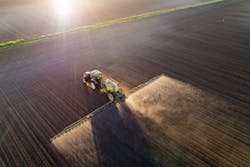Urea, originally a byproduct of human urine, is a critical chemical found in everything from fertilizers to skin care products to diesel-powered vehicles. Unfortunately, synthetic versions of urea are a large-scale, energy-intensive process that accounts for 2% of all energy use the world and a similar percentage of global emissions.
An international research team that includes scientists and engineers from the University of Texas at Austin has devised a new method for making urea that is more environmentally friendly than today’s process, and produces enough to be competitive with energy-intensive industrial methods.
Currently, synthetic urea is made using the two-step Haber-Bosch method. This method is widely considered one of the 20th Century’s greatest inventions because it made mass production of fertilizer possible and helped increase global food supply. It combines nitrogen and hydrogen to make ammonia, which then bonds with carbon dioxide to make urea. The process requires 400 to 500°F temperatures to get the reactions going.
The new process, however, takes just one step and relies on electrocatalysis, which uses some electricity and potentially sunlight to trigger chemical reactions in a solution at room temperature in ambient pressure. This method has been known for quite some time, but it was never economical because it could not produce large enough volumes of urea. It also created too many byproducts and required a lot of energy to break the molecular bonds to trigger the necessary reaction.
The key to making the process viable was finding the right catalyst, indium hydroxide nanomaterials, to create an efficient chemical reaction. It produces only what the researchers want, not a bunch of byproducts. And it creates a higher yield of urea than earlier attempts at using electrocatalysis.
The UT team also used nitrate instead of nitrogen to bond with carbon dioxide because it takes less energy to break nitrate bonds than nitrogen bonds, and that helps increase the urea output.
The team envisions electrocatalytic devices that could be operated by individuals and sold to farmers so they could generate their own urea to fertilize their fields. And the hope is to provide alternative solutions to large-scale industrial processes to reduce energy use.
Next steps in this process involve improving the yield, as well as a building prototype that ramps up production. The research team is also looking for a way to power the process using solar energy rather than electricity.

